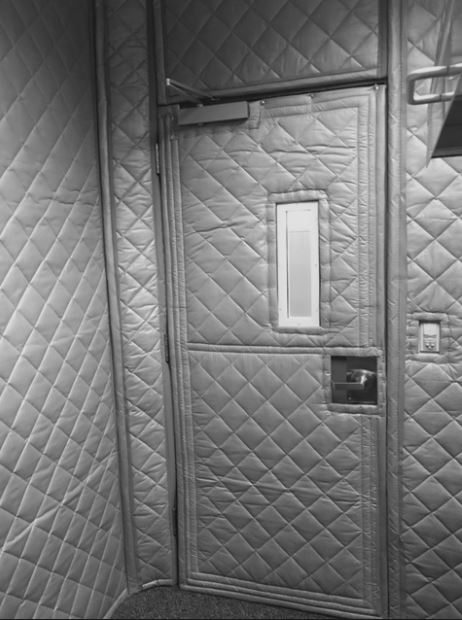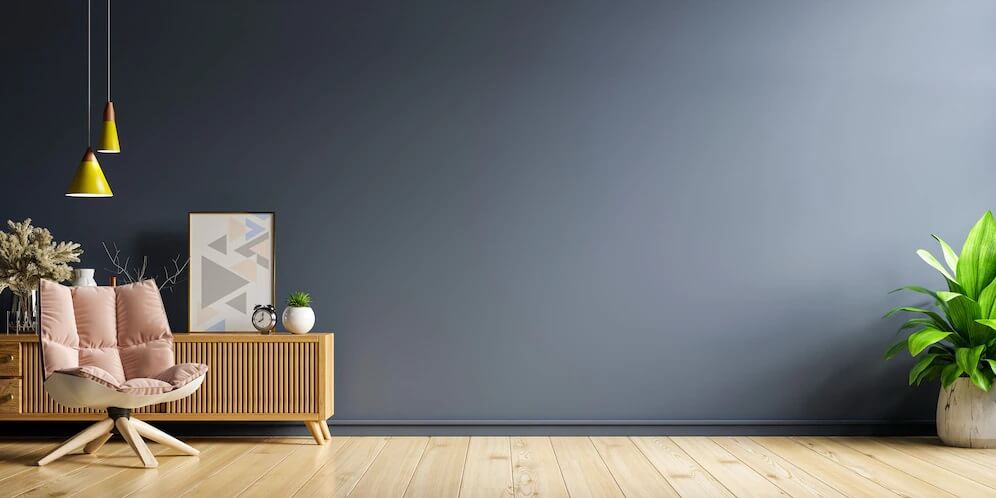How To Soundproof A Room With Moving Blankets
If you are on a budget and want to block out noises getting into your house, moving blankets is one of the best options.
The blankets are cheap, easy to use, and highly effective at soundproofing a house.
Like acoustic blankets, moving blankets work by reducing sound reverberations, noise reflection, and echoes through absorption.

What exactly are moving blankets?
Also known as moving pads or furniture pads, moving pads are made to be placed around furniture and fragile items during transportation.
There are many types of moving blankets. There are those stitched entirely from polyester, others from cotton, and others from non-synthetic fabrics.
Polyester moving blankets last longer due to the woven chevron pattern.
Moving blankets for soundproofing
When you choose moving blankets for soundproofing, go for thicker and heavier ones as they do a better job of cutting down on noise reflection, echoes, and reverberations.
Areas where you can use moving blankets
Walls
You can use curtain rods to hang the blanket, but for best results, use nails. Use a hammer to drive nails into each of the four corners of the blanket.
When choosing the blanket, go for one made from a breathable material. This calls for you to check whether the fabric you buy allows airflow, such as rayon, linen, cotton, or hemp.
Breathable fabrics absorb sound waves hence playing a vital role in dampening the noise.
Avoid blankets with a dense weave as they help the sound waves to bounce around the room, hence amplifying the noise.
If you aren’t sure whether the blanket is made from a breathable fabric, hold it up and try to blow through the material.
If you can feel air coming through, the material is breathable, and sound waves will easily penetrate and get absorbed by the blanket.
Some of the materials you should avoid include: nylon, fleece, polyester, and vinyl.
Floor
If you live in an apartment and hear the neighbors below, place a few good quality, thick moving blankets on the floor, and you will block the noise. The blankets are highly effective when you have a wooden floor.
Appliances
Do you have any noisy home appliances? Covering them with a moving blanket will go a long way in blocking most noise. You should be cautious about the appliances you cover, as covering some of them could be a fire hazard.
If your dishwasher, washing machine, or refrigerator is making a lot of noise, you can go ahead and cover it, but if it’s any other appliance, exercise caution.
If you aren’t sure whether you should cover the appliance, read the owner’s manual, or contact the appliance manufacturer.
Ceiling
Do you have noisy upstairs neighbors that keep on stomping around? Placing moving blankets on the ceiling will go a long way in reducing the excess noise.
Give your lease a second check and confirm that using nails isn’t against the rules.
Doors
The small openings around the top, bottom, and sides of the door allow the house noise and air.
If using nails or glue isn’t against the lease terms, go ahead and use them, but if it violates it, place a curtain holder over the doorway, then hang the moving blanket there.
Furniture
This caught me by surprise. When I was new in the soundproofing career, I didn’t understand why my supervisor would cover the tables and chairs.
After all, they weren’t making noise, right?
When you cover the furniture with a moving blanket, you reduce the hard surfaces in the room. As a result, sound waves don’t move.
If you have coffee tables, dining room sets, and other pieces that you feel are making the house louder, go ahead and cover them with a moving blanket.
Windows
If you live in a busy street and always hear traffic, you can eliminate the noise using moving blankets.
You need to adhere them to the windows the same way you would the curtains. For maximum results, block out the entire window or at least most of it.
Guide to using moving blankets to reduce excess noise

As mentioned above, moving blankets come in different designs and types. There are lightweight, heavyweight, and regular weight blankets.
The type you choose depends on the project you are having. If there is a lot of noise getting into the house, go for heavyweight blankets to absorb the noise much better.
When hanging the blankets on the walls, give a 2-inch space between the wall and blankets. This is to ensure that the blankets absorb as much noise as possible.
You can hang the blankets using different methods. You can use traditional nails, thumbtacks, or sticky tac.
Where to get moving blankets
If you recently moved, you most likely have moving blankets lying around, but what should you do if you don’t have them?
One of the best places to get them is on Amazon. Click here to see the best moving blankets for soundproofing.
You can also find the blankets in Walmart, Home Depot, U-Haul, and other moving companies.
When buying the blankets, always go for the heavier ones as they absorb the sound better.
You also should pay attention to the moving blanket material. Go for polyester moving blankets.
Since you will most likely be hanging the blankets off the walls, you will be better off buying those with eyelets or grommets already built-in, right?
These will make your work easy as you will have an easy time hanging them off the wall hooks. You should note that these tend to be a little bit expensive.
If your budget doesn’t allow it, buy grommet kits that will enable you to create your grommets in the blanket manually.
If you have never done it before, you can use plenty of resources. You can watch this video or this or this to learn how to do it.
Moving blankets Vs. Acoustic blankets
While you use moving blankets for the same role as acoustic blankets, you should note that the two aren’t the same.
Right off the bat, moving blankets aren’t designed for noise deadening or even muting sounds. They also aren’t tested for sound absorption.
As mentioned above, they are meant to wrap furniture and fragile items to prevent nicks and scratches during transportation.
Due to this, they might not provide the best soundproofing.
On the other hand, acoustic blankets are professionally designed to mute sounds; hence, they do a better job.
In addition to being thicker and weightier, they also feature several grommets stitched to provide better sound-blocking.
The fact that moving blankets aren’t designed for soundproofing doesn’t mean they won’t soundproof your home.
If there isn’t a lot of noise getting into the house, they will block the sounds. On the other hand, if you live next to a club or in a noisy neighborhood, the blankets might not block all the annoying sounds.
You should now think about upgrading to acoustic blankets in such a case.
Are there other cheap soundproofing options?
The prime reason people use moving blankets is that they don’t have large budgets.
If you are one of these people and don’t have a lot of money to spend on soundproofing materials, there are plenty of other ways in which you can soundproof your home for less.
Some of these other ways include:
Using rugs
Good quality rugs make excellent vibration dampeners.
If you have a noisy neighbor downstairs, placing a big thick rug directly over the area where the sound is coming will go a long way towards deadening the noise coming from the TV, stereo, or any other appliance.
While the rug won’t prevent you from hearing anything, it will take the edge of harsh noises, especially noise vibrations.
The cool thing is that in addition to the rugs muting the sounds coming from your neighbors, they will muffle your steps so you don’t make noise to your neighbors when walking.
Caulk
If the noise comes from sounds getting in from the gaps in the windows and doors, you should consider getting caulk.
Apply it in the gaps, then let it dry. You should note that you may have to re-caulk the areas with gaps every few years.
Weatherstripping
Popularly used to prevent moisture from getting in through windows and doors, weatherstripping is a highly effective and cheap method of soundproofing the door.
Weatherstripping is made up of slim rubber tubing that you should glue around the inside of the door or window frame. Apply it to the area where the door or windows meet the frame.
The weatherstripping will be compressed when you close the door, creating a watertight, sound-tight, and airtight seal.
If your windows and doors are poorly sealed, the weather stripping can make a huge difference. The cool thing is that it’s easy to install and, of course, affordable.
Green glue
This is eco-friendly noise-proofing glue meant to go on cement board, medium-density fiberboard, plywood, drywall, or orient strand board. After buying the glue, apply it to the affected areas at least half an inch.
Blankets
Blankets are beneficial when you have a soundproofing emergency. When you identify where the sound is coming from, muffle it with blankets.
If the sound is coming through the door, hang a blanket over the door and stuff blankets around the door frame to close up any gaps where the noise might be getting in through.
Is the sound vibrating through the walls? Hang your thickest blankets on the wall using nails.
Curtains
The existence of soundproofing curtains is a controversial topic in the soundproofing world.
Whether soundproofing curtains are a reality or myth, the fact of the matter is that having thick multilayered curtains will reduce the amount of sound getting into your room.
This is because the multiple layers will dampen the vibrations.
If you don’t already have a few curtains in the house, you should consider investing in a few. The cool thing is that they don’t have to be expensive. Simple, inexpensive ones are enough.
Strategic furniture placement
Did you know strategically placing the furniture in the problem areas will break up the sound waves and cause the sound energy to dissipate more quickly?
You should consider placing shoe racks or cabinets near the door, and you will break up the sound that travels through the gaps in the door flame.
If you have issues with the incoming sound vibrating through the wall, place upholstered furniture against the wall.
Carpets
If your home has laminate, wooden, tiling, or marble floors, you know that hard flooring transmits sound extremely fast.
Has your neighbor complained that you are stepping too loudly? Get a carpet.
While the carpet won’t eliminate the sounds, it will improve the room’s overall acoustics.
Homemade window blockers
Window blockers are what they sound like…they block the windows. No, these aren’t curtains or blinds.
These are big panels that fit precisely the window frame’s size, blocking all the light and sound from getting in the house.
If you don’t have the budget, you don’t have to buy the window blockers with minimal skills; you can easily create them from sofa cushions and other materials.
After making the panel, mount it on a hardwood board and seal it with acoustic sealant. The frame will absorb vibrations and noise.
Acoustic curtains
Acoustic curtains are elegant to look at. They also come with hooks, so you don’t have to ruin your walls when installing them.
In conclusion…
While moving blankets aren’t designed for soundproofing, they can deaden the sound when properly installed and make your home one of the quietest in your area.
To get the most from the blankets, go for high-quality thick ones. Strategically hang the blankets on the floor, ceiling, walls, doors, windows, or anywhere the annoying sounds are coming from.



